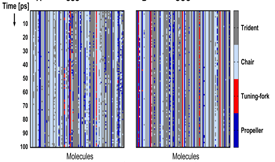
Isotropic Liquid State of Triacylglycerols
D. Golodnizky, Y. Shmidov, R. Bitton, C.E.S. Bernardes, M. Davidovich-Pinhas
J. Mol. Liq. 2022, 353, 118703.
Abstract
Over the years, several models of triacylglycerol (TAG) molecular conformations and bulk arrangements in isotropic liquid state have been proposed and are still up for debate. Such organization has a major impact on nucleation and crystal formation. The current research aims to further explore this debate by implementing experimental methods, such as X-ray diffraction and small-angle X-ray scattering coupled with a computational method, such as molecular dynamic simulation. These techniques were used to study tristearin and triolein as models for saturated and unsaturated TAGs, respectively. Four different conformations were suggested for the two TAGs, and the results showed conformation abundancy in the order: trident (Tr) > chair (Ch) > propeller (Pr) > tuning-fork (Tf). The existence of clusters was demonstrated for both TAGs, each of which exhibited a heterogeneous distribution of conformations. The preferability to find a specific pair of conformations next to each other was analyzed and, surprisingly, it was found that Tf will preferably pair only with Tr although Tf is the preferable conformation in most crystal polymorphs. High general conversion rates from any conformation to another, and high specific conversion rates from and to the Tf conformation were calculated. It is proposed that the high conversion rates observed enable the crystallization process, despite the low proportion of Tf molecules, which are in the suitable conformation for the crystal state. The conversion rates in triolein were lower compared with tristearin. This observation was ascribed to the lower simulated temperatures and the higher rigidity of the fatty acid chain induced by the double bond. Overall, the results confirm the formation of specific structures in liquid state, which combine all previously suggested models and further expand the knowledge using experimental and computational tools.
Return Previous Next